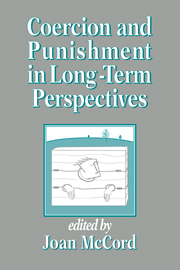Book contents
- Frontmatter
- Contents
- List of contributors
- Acknowledgments
- 1 Introduction: coercion and punishment in the fabric of social relations
- I Mental health, coercion, and punishment
- 2 Relationships as context: supportive and coercive interactions in competent, aggressive, and anxious mother–child dyads
- 3 Parental hostility, childhood behavior, and adult social functioning
- 4 Corporal punishment of children and adult depression and suicidal ideation
- II Family socialization practices and antisocial behavior
- III Aggression and coercion in the schools
- IV Deviance, crime, and discipline
- V Measuring and predicting in studies of coercion and punishment
- Name index
- Subject index
4 - Corporal punishment of children and adult depression and suicidal ideation
Published online by Cambridge University Press: 29 September 2009
- Frontmatter
- Contents
- List of contributors
- Acknowledgments
- 1 Introduction: coercion and punishment in the fabric of social relations
- I Mental health, coercion, and punishment
- 2 Relationships as context: supportive and coercive interactions in competent, aggressive, and anxious mother–child dyads
- 3 Parental hostility, childhood behavior, and adult social functioning
- 4 Corporal punishment of children and adult depression and suicidal ideation
- II Family socialization practices and antisocial behavior
- III Aggression and coercion in the schools
- IV Deviance, crime, and discipline
- V Measuring and predicting in studies of coercion and punishment
- Name index
- Subject index
Summary
Since the pioneering study of Elmer and Gregg (1967) there has been increasing recognition that the damage to children from physical “abuse” can involve more than broken bones and burns. There is compelling evidence that physically abused children also tend to suffer serious psychological injury and are at greater risk of engaging in crime (Egeland, Sroufe, & Erickson, 1983; McCord, 1988; Widom, 1989; Wolfe, 1987). However, the idea that ordinary and legal corporal punishment of a misbehaving child may also increase the probability of delinquency and later marital and psychological problems is seldom voiced in the United States. That should not be surprising because spanking and other forms of corporal punishment of children are routine events that are legal and for the most part expected of parents (Straus, 1991). Moreover, there are deeply ingrained psychological and cultural reasons why the possible harmful effects of corporal punishment are not perceived (Carson, 1987; Greven, 1991; Straus, 1994).
As a result of this combination of legal and moral legitimacy and psychological commitment, the general public and social scientists assume that corporal punishment is not an important social or psychological problem. The underlying assumption of this chapter is the opposite. It is that corporal punishment puts a child at risk of serious injury, both physical and psychological. To the extent that this assumption is correct, the wide use of corporal punishment is a major problem of U.S. society.
- Type
- Chapter
- Information
- Coercion and Punishment in Long-Term Perspectives , pp. 59 - 78Publisher: Cambridge University PressPrint publication year: 1995
- 10
- Cited by

